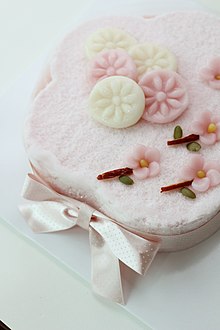Rice flour
This article needs additional citations for verification. (August 2023) |
Rice flour (also rice powder) is a form of
Rice flour may be made from either
Types and names

By rice
Rice flour can be made from
When made with
When made with brown rice with only the inedible outer hull removed, it is called brown rice flour (Chinese: 糙米粉; pinyin: cāomǐ fěn, Korean: 현미가루, romanized: hyeonmi-garu). Flour made from black, red, and green rice are each called as black rice flour (Korean: 흑미가루, romanized: heungmi-garu), red rice flour (Korean: 홍미가루, romanized: hongmi-garu), green rice flour (Korean: 녹미가루, romanized: nongmi-garu). In comparison to brown rice flour, white rice flour (Chinese: 白米粉; pinyin: báimǐ fěn, Korean: 백미가루, romanized: baengmi-garu) can be specified as so.
By milling methods
Different milling methods also produce different types of rice flour. Rice flour can be dry-milled from dry rice grains, or wet-milled from rice grains that were soaked in water prior to milling.
Uses
Culinary

Rice flour can be used to make
East Asia
In
In
Southeast Asia
In the
South Asia
In South India, rice flour is used for dishes like dosa, puttu,Chakkuli[7] golibaje (mangalore bajji) and kori rotti. It is also mixed with wheat, millet, other cereal flours, and sometimes dried fruits or vegetables to make manni, a kind of baby food.[citation needed]. Rice flour is used to make bhakari in the Konkan region in western India.
In Bangladesh, rice flour is a regular ingredient. In Bengali and Assamese cuisine of eastern India, it is used in making roti and desserts such as sandesh and pitha (rice cakes or pancakes which are sometimes steamed, deep fried or pan fried and served along with grated coconut, sesame seeds, jaggery and chashni). It is also used in making Kheer (a common dessert in Indian subcontinent).
In Sri Lanka, it is used in making many household food products. It is used in making food products such as pittu, appa (hoppers), indi appa (string hoppers) and sweets such as kewum, kokis, athirasa and many more. Also it can be used in making bread and other bakery products.
In Nepal, Newars use rice flour to make yomari and chataamari. Sel roti is another popular rice flour based food commonly eaten in Nepal and in the Sikkim and Darjeeling regions of India. Sel roti is known as Shinghal in Kumaon.
Central America
Rice flour is also used in the
Non-culinary

Cosmetics
Rice flour is used in the cosmetics industry.
Mushroom cultivation
Brown rice flour can be combined with vermiculite for use as a substrate for the cultivation of mushrooms. Hard cakes of colonised substrate can then be fruited in a humid container. This method is often (though not always) employed by growers of edible mushrooms, as it is a very simple and low-cost method of growing mushrooms.[citation needed]
References
- ^ Alden, Lori (1996). "Cook's Thesaurus: Rice". Lori Allen. Retrieved 2006-03-02.
- ^ ISBN 9780804820424. Retrieved 29 January 2013.
- ^ ISBN 9784770030498. Retrieved 29 January 2013.
- ^ ISSN 0367-6293.
- ^ E.B. Bennion (1997). The Technology of Cake Making. Springer. p. 15.
- ISBN 9781613128084.
- ^ "easy chakkuli recipe using ready flour". Udupi Recipes. Retrieved 28 March 2024.
External links
- Japanese rice flours at japanesericeflour.com
- Nepali Chatamari
